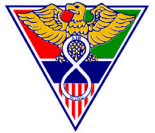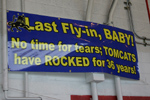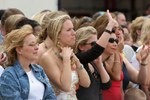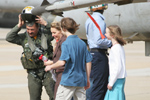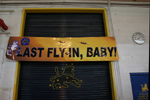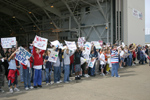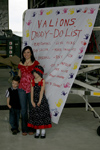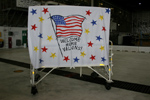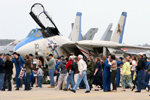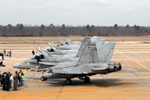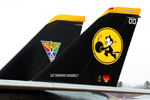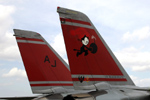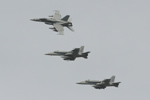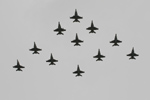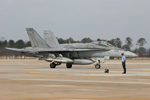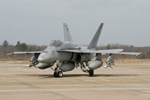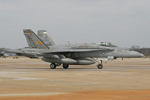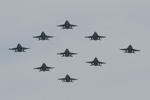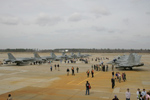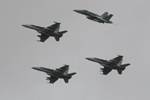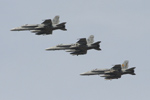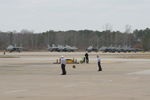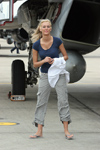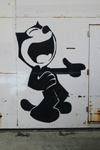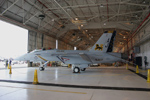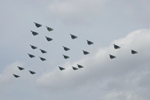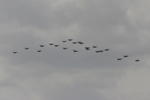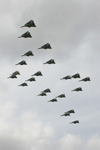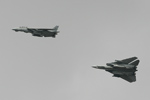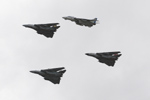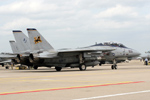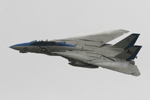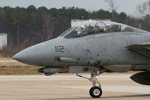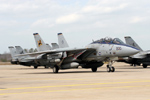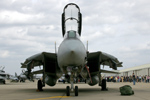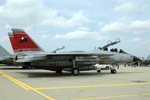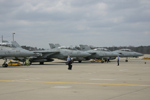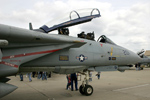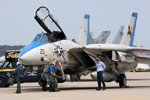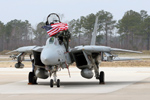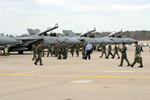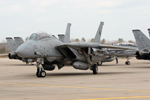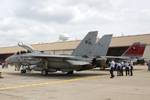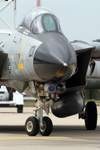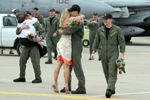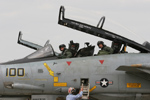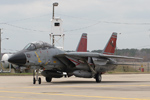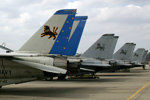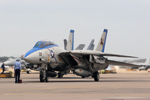March
10th 2006 was a day of mixed emotions for many of those gathered at
NAS Oceana. The families and friends of the homecoming crews were clearly
excited at the prospect of being re-united with their loved ones and,
inside each respective squadron hangar, tables, chairs, refreshments
and entertainment had been put in place for all the pending squadron
parties. The children of the crews had made their own homecoming banners,
which they intended to hold aloft and wave with great excitement at
the sight of seeing their mums and dads. But, for some, it was also
the day when the last two operational F-14D Tomcat squadrons, VF-31
“Tomcatters” and VF-213 “Black Lions”, would
complete their operations with this much respected aircraft and the
final curtain on its service life was almost drawn. VF-213 will begin
transitioning to the F/A-18F Super Hornet immediately and become VFA-213.
VF-31 will continue their Tomcat operations although some of their current
11 aircraft need to be replaced as they are almost out of airframes
hours. These replacement aircraft will be lower houred ex-VF-213 aircraft
and the remainder of the VF-213 Tomcats will be disposed of with some
going to museums, a few will be put into storage whilst the others will
go into SARDIP (Stricken Aircraft Reclamation and Disposal Program).
|
|
|
There
is also a strong possibility that VF-31 will fly one or more of their
aircraft at the NAS Oceana Airshow on 9th/10th September 2006. Although
this airshow appearance rumour is not confirmed, it would be a fitting
end to the Tomcats career to make one final flyby at a public event.
VF-31 is expected to participate in the Tomcat Sunset events to be held
on 22nd September where they will make the final Tomcat flight and it
is believed that “Tomcatter 111” BuNo 159600 will be the
airframe - the significance of this aircraft is that it is the oldest
airworthy airframe in the squadron and by maintaining its airworthiness
it will be a testament to the serviceability and capability of the aircraft
that has served the US Navy for 36 years. Following this event VF-31
will then say farewell to their Tomcats and in October they will become
VFA-31 when they begin their transition to the F/A-18E Super Hornet
with these aircraft being transferred to their charge from another squadron,
VFA-22. The legendary Grumman F-14 Tomcat will then pass into history. |
On a day with unusually warm temperatures for early March and with winds gusting up to 30mph, at approximately 9.50am the first squadron appeared in the Oceana skies. The eleven F/A-18C’s of VFA-15 “Valions” approached the base from the north east in a diamond formation, with faces turned to see them and fingers pointing, the formation made its fly-by to the cheers and clapping of the those gathered at their hangar. The arrowhead formation then split into smaller three and four jet formations which each made another fly-by and then each jet peeled away to make its approach for landing. One by one each jet touched down on the runway and after a brief wait they taxied to their ramp parking positions in pairs. The ground crews had been in position on the ramp awaiting the jets for some time and slowly, one by one, each jet parked up. Interestingly, some of the jets were carrying armaments on their pylons and noteworthy were those aircraft carrying SLAM-ER, AGM-88 HARM, AIM-7 Sparrow and AIM-9X Sidewinder missiles. With all the squadron jets parked up, engines were shut down and canopies were opened. As the crews unstrapped themselves and began to exit their jets, they were greeted by their families and friends who rushed onto the ramp, families were again re-united. |
|
|
The
next squadron to return was VFA-87 “Golden Warriors”. At
approximately 11.15am, the nine aircraft of the squadron over flew Oceana
in a diamond formation and again the families and friends present in
the squadron hangar cheered and clapped as the jets passed overhead.
The main formation split into smaller formations and each section made
another fly-by as one by one the jets again peeled away for finals for
landing. Due to the location of the squadron hanger and the time delay
in getting the jets to taxi back to their ramp, it was not possible
to witness the re-unions because the word was that the Tomcat squadrons
were now en-route to the base and with the Tomcat squadron hangars located
at the other end of the base it was to be a quick dash to get there
in time for their arrival. |
Upon
arrival at the Tomcat hangar - Hangar 500 - it was evident that this
was the place to be as a large number of people had gathered there,
more than any other hanger, and consisted of not just families and friends
but also people who had been involved with the Tomcat since it first
entered US Navy service in 1974. Some aircrew from VFA-103 “Jolly
Rogers”, another ex-F-14 squadron, had positioned themselves on
top of their hanger to get a better view of events, and amassed outside
the Tomcat hangers were some local TV crews who were preparing themselves
for live broadcasts of the event whilst other media types jostled to
get a good position to witness what was about to happen, the atmosphere
was electric. |
|
|
Parked
inside the hanger of VF-213 was an example of the squadron’s future
mount, an F/A-18F Super Hornet resplendent in the markings of VFA-213.
For some though, the feeling is the Super Hornet lacks soul compared
to the Tomcat, so for those Tomcat crews transitioning to the Super
Hornet they will hopefully bring and give the jet the soul it needs
to become one of the great Navy aircraft.
At 12.00 all eyes were again searching the skies to the east of the base. An airband radio of one enthusiast crackled into life as the Tomcats made contact with Oceana tower and reported they were 40 miles from the base. The next radio call was 30 miles from the base, then 20 miles, 10 miles and then someone was overheard saying “Wow, here they come … awesome!” |
Awesome
it was and what a truly incredible sight … all 22 Tomcats of CVW-8
were together in one large formation all with their wings fully swept
back, a formation which could have been called “the wedge formation”
it was a sight that everyone knew would never be seen again. A strange
silence seemed to have befallen the gathered crowd as they looked at
the approaching jets, a silence that was to be shattered as the formation
fly-by roared past their hangers where it was greeted with cheers, applause
and the sound of the photographers’ camera shutters clicking away
taking continuous pictures of the jets, all of which were muted by the
sound of the engines. Outside the base there was also a lot of interest
in wanting to see the Tomcats, many people had also gathered at vantage
spots along the Oceana Boulevard road to witness this memorable event. |
|
|
The
formation was led by Capt. William G. Sizemore III, commander CVW-8,
flying the VF-31 jet “Tomcatter 100” painted with the black
tail and large yellow “Felix” squadron insignia tail markings,
he was flanked by the two “showbird” jets of VF-213, “Black
Lion 200” with dark blue markings on the right, “Black Lion
213” with pale blue markings on the left, and behind them was
the VF-31 jet “Tomcatter 101” with the red-tail and black
“Felix” markings. The formation then separated for landing
and made fly-bys of formations of three or four aircraft before making
the break to land. Tomcats landed on both the parallel runways and then
taxied to a holding point on the far side of the airfield in front of
their hangers. The final Tomcat to land was VF-213’s “Black
Lion 213”. When the final jet was in position on the taxiways,
the jets that had been holding on the far side of the airfield began
to move forward to taxi to their parking positions on their respective
ramps. One by one the jets were called forward, an aircraft from each
squadron in turn. As each aircraft was parked up the engines were left
running. |
The
sound of the engines whining and howling was deafening and became even
more so as the last Tomcats, the CAG/Show Birds, parked up with all
44 General Electric F110-GE-400 afterburning turbofans running. This
noise seemed to last an eternity but then, at approximately 12:15, with
one radio call to all pilots, the engines were simultaneously shutdown.
Both squadrons’ crews then opened their canopies in unison and
the crews began to leave their jets and assemble in front of them. The
crew of VF-31 aircraft “Tomcatter 105” held up the stars
and stripes ensign from the cockpit as a sign of pride for their families,
pride for the Navy and pride for the Tomcat. With all the jets declared
safe, the families and friends ran to greet the crews. The Tomcats were
safely home. |
|
|
Throughout
the Tomcats 36 year service history, it has undergone numerous upgrades
and modifications all necessary to meet the demands of the Navy and
to keep it the premier carrier-based multi-role strike fighter. For
the crews who keep the jets operational and the pilots who fly them,
the retirement of the Tomcat was a hard, but necessary, decision to
accept. "It is one of the greatest fighter planes in history,"
said Lt. Chris Rattigan, a pilot with VF-31, who went on to say "when
you think of naval aviation, you think of the Tomcat." Cdr Richard
La Branche, VF-31 commanding officer said "I will miss flying the
Tomcat very much. Saying goodbye to the Tomcat will be like saying good
bye to an old friend, but in the best interest of our people, it must
be done." |
There's
no time for tears, Tomcats have rocked for thirty-six years. So long,
BABY! … |
|
| The author would like to extend special thanks to Troy R. Snead, PAO NAS Oceana; Cdr. Richard “Corky” Erie NAS Oceana Air Operations Officer; all the members of the PAO teams who helped on the day; all the pilots and crews of VFA-15, VFA-87, VF-31 and VF-213 for making this article possible. |

